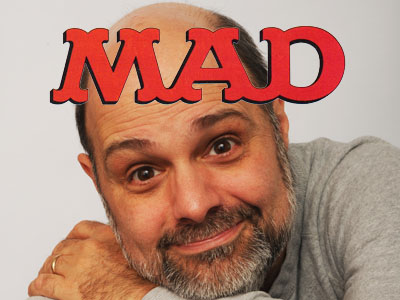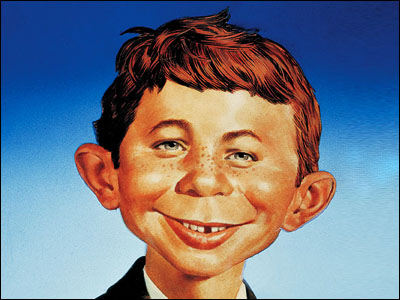
That's a photo of Joe Raiola, a writer of very funny things who was a member of the editorial staff of MAD for 33 years. This morning, he posted the following to Facebook. I'll be back after it to add on my thoughts but I only disagree with two things Joe says…
During its long run, MAD Magazine inspired many second-rate imitators. There was Cracked and Sick and Crazy and so on. Oddly enough, the latest MAD imitator is MAD itself. The MAD published out of Burbank since the spring of 2018, which is being shut down, is an imitation of the real thing.
I say this not as a shot at the new MAD staff, which was thrust into an impossible situation. Not a single member of the editorial staff had any previous MAD experience, except as readers.
From 1952 to 2017, MAD had a remarkable continuity of talent. DC, which took over after Bill Gaines died in 1992, is a comic book company specializing in flying caped aliens. The former MAD staff offered sufficient resistance to remain editorially independent. And, to its credit, DC came to respect the MAD staff, even if the suits didn't fully understand the mechanics of creating a humor magazine.
When DC moved to California in 2014 and the MAD staff refused to go, DC wisely decided to leave MAD in New York. In November of 2017, Rolling Stone wrote: "Operating under the cover of barf jokes, MAD has become America's best political satire magazine."
Bottom line: For MAD to have had a chance to survive, it needed to remain in New York and the editorial reins been passed on to the "junior" staff, which had been in place for nearly two decades. That did not happen and this is the predictable result.
On a more positive note, I just found out that in 15 minutes I can save 15% on my car insurance.
Some might dismiss Joe's words as grapes of the sour kind but I don't think he's wrong except that I liked the new MAD, at least in its first issue or two, more than I think he did. Secondly, I think it's conceivable MAD could have benefited from the right "new blood" inserted into (but not displacing) the old structure and that didn't have to happen wholly in New York. I think what went awry here is much the same thing I see as a problem with just about everything that comes out of DC Comics these days…
If you talk to anyone who works there these days — anyone! — they will tell you this: That you come to work each day wondering who's going to get fired. Eventually, inevitably, it will be you…but until that time, you won't be sure who'll be above you next week. I would imagine the decision to suddenly and unexpectedly amputate most of the MAD division has only contributed to that environment. The answer to the question "Who's in charge?" is "I dunno. What time is it?"

Now, to be fair, MAD Magazine has long faced a problem that even the former staff could not make go completely away: It's a magazine. Magazines don't do that well these days and every danged one of them that's been around for a while is selling a fraction of what it once sold. On a percentage basis, Playboy hasn't fared much better than MAD and it's not because Americans are getting sick of looking at beautiful nude women. People just don't read magazines of any kind the way they used to.
The easy assumption is that this is the result of that new-fangled "internet" thing but it's actually a trend that began before any of us had handles or e-mail addresses. The eruption of online communication and entertainment merely turned a trickle into a waterfall.
I'm going to pause my add-on to Joe's essay here and insert one by my pal Paul Levitz, who ran DC Comics (and therefore presided in a business sense over MAD) for many years. Paul also posted what follows this morning on Facebook. Take special note of the one passage I have highlighted…
Culturally speaking, MAD Magazine is probably the most powerful print entity to emerge from the comics industry. At its peak (ironically, the Poseidon Adventure parody issue…only MAD could crest with a story about sinking)…MAD had a circulation over 2 million copies an issue, a pass-along readership that was a multiple of that, and was the magazine sold at the largest number of outlets in the U.S. and Canada. Its impact on the broader popular culture, spreading a snarky, borscht-belt, NY Jewish sense of humor and cynical attitude towards advertising, government, big business and human behavior, is immeasurable.
Founders Harvey Kurtzman and Bill Gaines, and editors Al Feldstein, Nick Meglin and John Ficarra who built on the foundation and made it a towering institution shaped the Baby Boom generation, inspiring movements from underground comix to Vietnam War protests. And the Usual Gang of Idiots — the incredible, long serving writers and cartoonists who filled the magazine — brought styles that even the most art-blind kid could recognize, they were each so distinctive and personal.
I've been proud to be a friend to some of the gang since my adolescence, and to have served as MAD's publisher for 17 years. I can't say I contributed much to its glory: I never found the business model to help it adapt to the changes in our culture, to kids' reading patterns, and technology that has accelerated the cycle of snark. But we tried, again and again.
MAD the magazine may be gone, but its legacy lives on in our conversations and our attitudes. I wrote about how the different editors' world views shaped the magazine (and our mindsets) in Studies in American Humor, Vol. 3, No. 30, a few years ago — using the vehicle of an interview with Al Jaffee, the then only "Idiot" to have worked with all of the MAD editors. There's an academic press book version of that issue coming out eventually, and much will be written about the fading of this American institution.
But today, I'm just sad.
Paul, one of the humblest guys I know, is shouldering way too much of the blame in the highlighted passage. Everyone at or around MAD for decades struggled to find that business model that would allow a magazine to thrive in a declining market for magazines.
A lot of what they did helped for a time. Purists shrieked when MAD began accepting advertising again — yes, again. Those who moaned that it was a betrayal for MAD to contain ads for "the first time" were unaware that it once had. But that move in 2001 kept the publication in the black as did upgrades in the area of interior color and print quality and various reprint projects.
What really kept MAD alive in perilous times though were (a) its tradition and (b) its content. As I've written here several times, I thought its content was really, really strong the last decade or two. There was some brilliant comedy writing in its pages.
If MAD had been the product of a small publisher working out of a low-rent office somewhere, that might have been enough. The hefty overhead of being a Time-Warner project — and their overall business model of seeking to monetize every property in every medium — caused MAD to fall short. I do not think it's gone forever. I'd bet my complete collection of that publication that the brand is too valuable to not be relaunched before long.
I just think they don't know what to do with it now…and that I blame a lot on that "Who's running the store?" problem I mentioned earlier. Since MAD was wrested from its New York crew, the answer to that question has been "Everybody" and when everyone's running the store, no one's running the store. My pal Bill Morrison was editor for a time and if you absolutely had to have someone with no MAD experience running MAD, you couldn't ask for a better pick. The problems there were that to the extent Bill was able to run it, it was in an unstable environment…and that it was still, when you got right down to it, a magazine.
I do not have a solution to that not-tiny problem. My gut tells me there is one but what the hell does my gut know about marketing? I just don't think giving up and abandoning MAD's long-established spot on newsstands and killing the "tradition" is a solution. Once those outlets stop making room for MAD on their racks, it'll be ten times as difficult to get them to clear a spot for it ever again.

Creatively, what MAD needs is a stability that I don't know is possible in the current corporate structure there. I know that the new MAD may have claimed to be the output of "The Usual Gang of Idiots" but it wasn't. The "idiots," such as they are, were not in any sense "usual."
When I fell in love with that publication in 1962, every issue was the work of more-or-less the same people: Mort Drucker, Don Martin, Antonio Prohias, Dave Berg, Frank Jacobs, Larry Siegel, Stan Hart, Al Jaffee, etc. They didn't even have Sergio Aragonés when I started buying the thing but he came along shortly after and quickly became a star there, a highlight among many in every issue. The last true star I think MAD added to its roster was Tom Richmond and that was around the turn of the century.
In the new MAD, you have a few holdovers from the previous regime like Sergio, Jaffee, Richmond, Dick DeBartolo and one or two others. But most of the magazine has been filled with transients…folks who look like they're auditioning even though no ongoing positions seemed to be available. The folks running MAD lately haven't found the new Don Martin, the new Jack Davis, another caricaturist besides Richmond worthy of occupying the space Drucker once did, etc. I don't believe it's because such people don't exist. I just think that's the way Time-Warner operates these days.
No one person among the mob of those who work on them can say what's right for Superman or Bugs Bunny or Batman or Tweety or any of the wonderful properties they've accumulated over the years. None of those folks created the properties. None of them has the overriding say as to what's right or wrong for them. And not one of them can reasonably expect to be associated with that property for long. All those legendary characters are being raised by baby-sitters, not by actual parents. Not even foster parents.
The demise of MAD is a failure of marketing and distribution and promotion; of no one finding that elusive business model that Paul mentioned. But even a sound business model needs a sound product to sell and I'm not sure it's possible to create that in a workplace where even the highest-ranked exec is really a well-paid (for now) office temp. Joe Raiola was right. The less MAD was controlled by corporate overlords, the better it was.